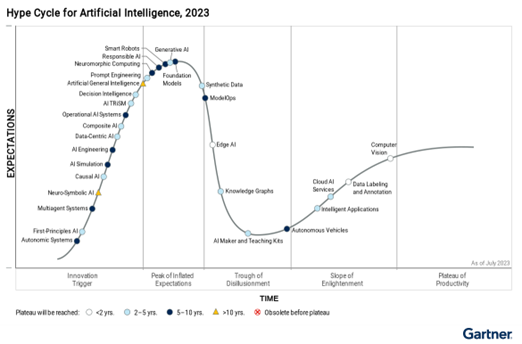Is the Generative AI hype real? A look at the AI Gartner Hype Cycle
6 September 2023

In today’s world, it is hard to escape the hype surrounding Artificial Intelligence (AI), Generative AI and its applications. From self-driving cars, ChatGPT and deep fakes, everyone has heard about the potential AI has in transforming industries and domains, as well as the world as a whole.
But is this hype real?
That’s exactly the question the Gartner Hype Cycle aims to answer. The Hype Cycle for AI evaluates the maturity and adoption of specific AI technologies and applications, which gives us a chance to evaluate their impact.
From spark to maturity: The 5 stages of the cycle
According to the Gartner Hype Cycle each new technology goes through five distinct stages.
- The Innovation Trigger is the point at which a new concept is introduced. The technology, often without viable real-life products, is in its infancy but proof-of-concepts are arising.
- The Peak of Inflated Expectations is the point where a technology is surrounded by hype and excitement. Technologies in this stage seem to be revolutionary and with limitless potential. You probably have a couple of (AI) technologies in mind that fit in this category.
- After this period of anticipation, the technology starts to descend into the Through of Disillusionment. Solving real-life problems can identify limitations, leading to setbacks and disappointment.
- These challenges provide important insights and lessons learned which brings the technology into the Slope of Enlightenment. At this stage, the technology’s value is becoming increasingly clear in specific domains and scenario’s.
- As the technology becomes an integral part of various domains and industries it reaches the final stage, the Plateau of Productivity. What once was only a spark of innovation has now reached maturity.

Generative AI: All buzz, no substance?
Generative AI is probably the most talked about technology of the last year. It is one of the most disruptive and promising technologies that has been introduced in the last 10 years. Therefore it is only logical that it also plays an important role in this year’s Gartner Hype Cycle, which places generative AI at the peak of inflated expectations. It is hard to argue with this positioning, in the last year we have all read a number of headlines which highlight the potential and performance of generative AI tools such as ChatGPT, DALL-E or Midjourney. These reports drive the hype surrounding this technology.
However, in our experience generative AI comes with its own challenges, such as hallucinations, bias and possible security concerns. These challenges need to be tackled to have a successful generative AI solution and will probably be the key issues which need to be solved to let generative AI evolve into a mature AI technology. So does that mean that generative AI in its current stage has no substance or value? On the contrary! If applied to the right problem, these tools can already be transformative and lead to tangible benefits.
Fueled by Generative AI & Fuel for Generative AI
The Gartner report also highlights other emerging technologies which can form a symbiosis with Generative AI technologies. A first group of technologies are the technologies which are fueled by advances in generative AI, such as AI engineering and prompt engineering. AI engineering is a discipline which unifies DataOps, MLOps and DevOps to create develop, deliver and operationalize AI systems. It is clear that generative AI technologies, such as LLMs and diffusion models, drive an increasing need to industrialize these models into AI solutions. Prompt engineering is a discipline which was ‘born’ together with generative AI. Just like using specific keywords for better search engine results, prompt engineering aims to tailor the input of AI models to get the desired outputs.
A second group of technologies will be fueling generative AI technologies, such as knowledge graphs. Knowledge graphs organize facts, concepts and their relationships in a structured way. The integration of knowledge graphs and generative AI can improve their accuracy by incorporating reliable and validated facts into their generated content.
What steps should you take?
At Datashift we believe in AI technologies and their current and future possibilities. However, we also believe that companies should not jump into adopting a specific AI technology just because the hype surrounding it or seems like it is a checkbox that should be ticked off. AI initiatives should be integrated with the core objectives and challenges of the business and the people within. What do you want to achieve? How do you want to create impact? These are the fundamental questions that should be answered together before evaluating whether AI can be a possible solution to do this.
Are you interested in discovering the business challenges that could be solved with AI solutions? Or would you like to know more about AI solutions and technologies? At Datashift we are ready to support companies in the different phases of their AI journey and needs. Curious what we can do for you? Reach out!
